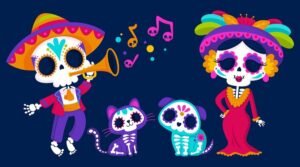Blogs

- by Adminneigh
The Tradition of Día De Los Muertos: Honoring Our Loved Ones

Welcome to Neighborhood Friends, where we celebrate cultural traditions and promote learning through play. On this occasion, we want to share with you the beautiful Mexican tradition of the Day of the Dead. This holiday full of color and meaning allows us to honor and remember our departed loved ones.
The Day of the Dead, celebrated mainly in Mexico, is a holiday that takes place on November 1 and 2. Although it may sound sad, it is actually a celebration full of joy and love, where families come together to remember their loved ones and celebrate life.
Why is Day of the Dead celebrated? This tradition dates back to the ancient indigenous cultures of Mexico, such as the Aztecs. They believed that death was not the end, but the beginning of a new cycle of life. Therefore, Day of the Dead is an opportunity to connect with our ancestors and keep their memory alive.

What is celebrated during the Day of the Dead? During this holiday, colorful altars called “ofrendas” are built in homes and cemeteries. These offerings are decorated with flowers, candles, photographs of deceased loved ones and objects that they enjoyed in life. Food and drinks that they used to like are also placed, so that the souls of the deceased can enjoy their essence.



La Catrina is an iconic symbol of the Day of the Dead. She represents an elegant skeletal figure dressed in sophisticated clothing. This figure was created by the famous Mexican illustrator José Guadalupe Posada and has become an emblem of the holiday. La Catrina reminds us that, regardless of our social position, we are all equal in the face of death.
To create the Day of the Dead catrinas, various materials are used, depending on the technique and preference of each artisan. Some of the common materials used are:
1. Paper mache: It is a material that is obtained by mixing shredded paper with glue and water. It is used to create the structure of the catrina and give it shape.
2. Cardboard: Used to reinforce the structure of the catrina and create details such as arms, legs and accessories.
3. Paint: Used to give color and life to the catrina. Acrylic paints or spray paints can be used to achieve different effects.
4. Fabric: Used to dress the catrina and give her an elegant look. Fabrics of different colors and textures can be used to create dresses and accessories.
5. Decorations: Various decorative elements such as feathers, sequins, paper flowers, lace, ribbons, among others, can be used to add details and ornaments to the catrina.
It is important to note that creativity and imagination are essential when creating a catrina, so the materials may vary according to the vision and style of each artist.


At Neighborhood Friends, we value cultural diversity and the importance of teaching our little ones about the traditions of different countries. Día de los Muertos is an opportunity to teach our children about the importance of honoring our loved ones and celebrating life. We hope this text has been engaging and easy to read, and that it inspires you to immerse yourself in the beauty of this wonderful tradition. Happy Day of the Dead!

1. Altars: One of the most important traditions of the Day of the Dead is the creation of altars in honor of deceased loved ones. These altars are usually decorated with photographs of the deceased, candles, marigold flowers, foods and drinks that they liked, as well as personal objects that were meaningful to them
2. Sugar skulls: Sugar skulls are another iconic element of the Day of the Dead. These skulls, decorated with bright colors and elaborate designs, represent death in a festive and joyful way. They are often placed on altars or given as gifts.
3. Bread of the dead: Bread of the dead is a sweet and spongy bread that is consumed during the Day of the Dead festivities. It is usually decorated with bone shapes and a ball at the top that represents the skull. It is common to share this bread with family and friends, both at altars and at meetings.


COCO movie synopsis
Miguel is a boy who dreams of being a musician, but his family forbids it because his great-great-grandfather, a musician, abandoned them, and they want to force Miguel to be a shoemaker, like all the members of the family. By accident, Miguel enters the Land of the Dead, from which he can only leave if a deceased relative grants him his blessing, but his great-great-grandmother refuses to let him return to the living if she does not promise that he will not be musician. Because of that, Miguel escapes from her and starts looking for her great-great-grandfather.

